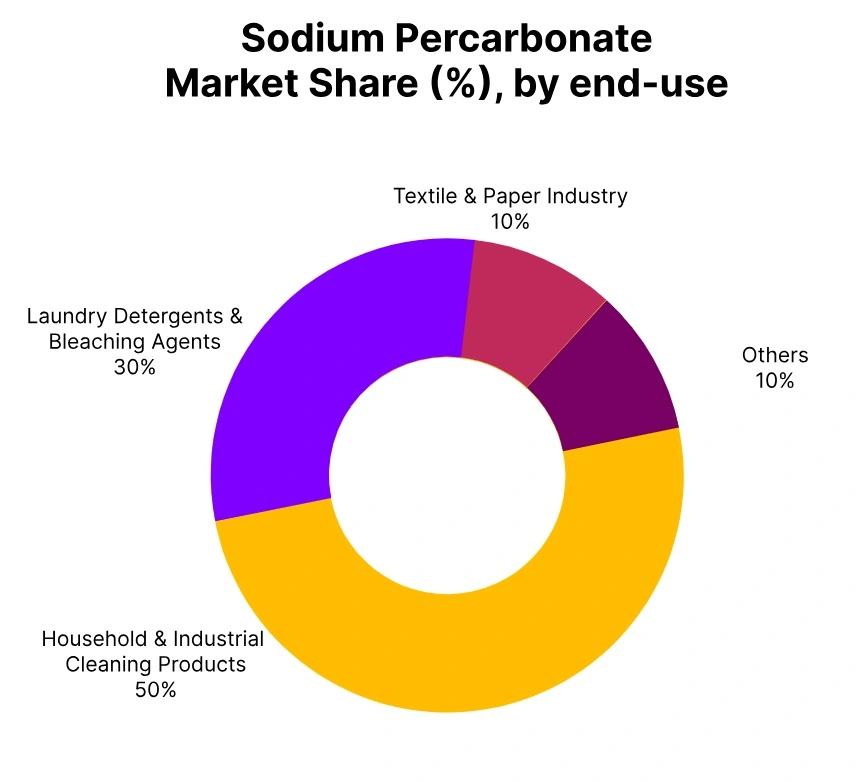Sodium Percarbonate Price Trend Q3 2025
In Q3 2025, the global sodium percarbonate market experienced a mix of price fluctuations across different regions. Most countries importing from China, such as Indonesia, Malaysia, South Korea, and Vietnam, saw price declines. Conversely, India and Japan saw slight price increases, driven by steady demand in key sectors such as cleaning, laundry, and industrial applications. In September 2025, sodium percarbonate prices in regions like India and Japan continued to see modest increases, reflecting resilience in industrial demand. The sodium percarbonate price trend in Q3 2025 was impacted by regional demand fluctuations and the global industrial slowdown.
China
Sodium percarbonate Export prices FOB Shanghai, China, Grade- Coated (Active Oxygen_min.13%).
Sodium percarbonate prices in China fell by 4.6% in Q3 2025. This decrease was mainly due to lower demand from sectors such as cleaning, laundry, and chemicals. The global economic slowdown and dip in industrial production contributed to the decline in prices. In September 2025, sodium percarbonate prices in China remained subdued, reflecting weaker demand from key sectors.
Sodium percarbonate price trend showed broader market conditions, with reduced consumption pushing prices lower despite steady production levels. The slowdown in global markets, combined with domestic demand weaknesses, led to sustained cheaper prices throughout the quarter, reflecting the ongoing challenges faced by the industry.
Indonesia
Sodium percarbonate Import prices CIF Jakarta, Indonesia, Grade- Coated (Active Oxygen_min.13%).
Sodium percarbonate prices in Indonesia, importing from China, dipped by 6.0% in Q3 2025. This decline was driven by less demand from the cleaning and laundry industries, which experienced slowdowns. Indonesia’s reliance on imports from China added to the price drop, as global supply chain pressures and reduced consumption in key sectors impacted local pricing. In September 2025, sodium percarbonate prices in Indonesia went on to reflect this downward trend. Sodium percarbonate price trend in Indonesia showed a decline, driven by lower demand from industrial and consumer sectors, and reflected the overall slowdown in regional markets. This resulted in continued price reductions despite steady import levels.
Malaysia
Sodium percarbonate Import prices CIF Klang, Malaysia, Grade- Coated (Active Oxygen_min.13%).
Sodium percarbonate prices in Malaysia, importing from China, dipped by 4.3% in Q3 2025. This reduction was due to decreased demand from key sectors including cleaning, detergent manufacturing, and textiles. Slower industrial activity in Malaysia, coupled with lower consumption of sodium percarbonate in production processes, led to the price drop.
In September 2025, sodium percarbonate prices in Malaysia remained pressurised, continuing to mirror the broader market slowdown. Sodium percarbonate price trend in Malaysia mirrored the regional decline, with soft demand contributing to the price decrease. This reflected broader economic challenges in the region, with sluggish industrial activity affecting pricing.
India
Sodium percarbonate Import prices CIF Nhava Sheva, India, Grade- Coated (Active Oxygen_min.13%).
Sodium percarbonate prices in India, importing from China, went up by 0.8% in Q3 2025. The price increase was stabilised by steady demand from sectors such as cleaning, textiles, and agriculture, which helped sustain consumption. India’s industrial demand for sodium percarbonate remained relatively strong, contributing to the price rise.
According to PriceWatch, in September 2025, sodium percarbonate prices in India went on to show modest growth, driven by consistent industrial consumption. Sodium percarbonate price trend in India showed resilience, with moderate price increases due to steady demand in key sectors, indicating ongoing strength in the domestic industrial market and suggesting a stable demand for sodium percarbonate.
South Korea
Sodium percarbonate Import prices CIF Busan, South Korea, Grade- Coated (Active Oxygen_min.13%).
Sodium percarbonate prices in South Korea, importing from China, dipped by 4.4% in Q3 2025. The price drop was primarily due to softer demand from the detergent and cleaning industries, which saw slower production. South Korea’s reliance on imports from China contributed to the overall price fall, reflecting the global trend of weak consumption in key sectors. In September 2025, sodium percarbonate prices in South Korea went on to show a decline, in line with regional trends. Sodium percarbonate price trend in South Korea mirrored the broader market downturn, with a lack of demand fueling the price drop during the quarter and reducing market confidence.
Vietnam
Sodium percarbonate Import prices CIF Haiphong, Vietnam, Grade- Coated (Active Oxygen_min.13%).
Sodium percarbonate prices in Vietnam, importing from China, dipped by 4.4% in Q3 2025. This decrease was driven by weaker demand in the cleaning and detergent industries, which experienced slowdowns in production. Vietnam’s reliance on imports from China influenced the price drop, as global supply chain disruptions and softer demand impacted local prices.
In September 2025, sodium percarbonate prices in Vietnam remained subdued, continuing the downward trend observed earlier in the quarter. Sodium percarbonate price trend in Vietnam mirrored the broader market conditions, with less consumption in key industries contributing to the price decline and reflecting ongoing challenges in the local market.
Japan
Sodium percarbonate Import prices CIF Tokyo, Japan, Grade- Coated (Active Oxygen_min.13%).
Sodium percarbonate prices in Japan, importing from China, went up by 2.2% in Q3 2025. This price rise was driven by steady demand from the cleaning and personal care industries, where sodium percarbonate is a key ingredient. Despite global economic challenges, Japan’s industrial demand for sodium percarbonate remained resilient, helping to push prices higher.
In September 2025, sodium percarbonate prices in Japan continued to show modest growth, reflecting stable consumption. Sodium percarbonate price trend in Japan showed positive market conditions, with strong demand from key industries supporting the price increase, even amid global market uncertainties and broader economic slowdown pressures.


